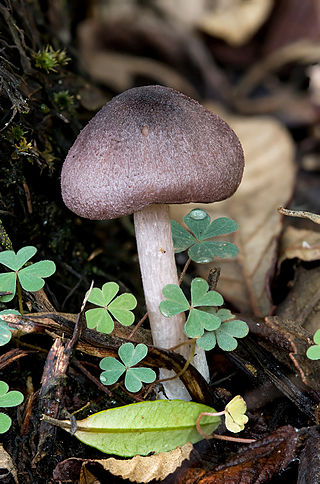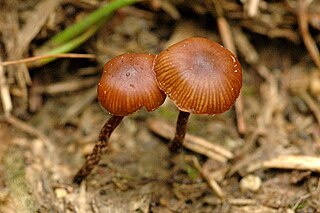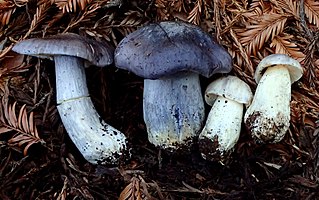
Hygrocybe is a genus of agarics in the family Hygrophoraceae. Called waxcaps in English, basidiocarps are often brightly coloured and have dry to waxy caps, white spores, and smooth, ringless stems. In Europe they are characteristic of old, unimproved grasslands which are a declining habitat, making many Hygrocybe species of conservation concern. Four of these waxcap-grassland species, Hygrocybe citrinovirens, H. punicea, H. spadicea, and H. splendidissima, are assessed as globally "vulnerable" on the IUCN Red List of Threatened Species. Elsewhere waxcaps are more typically found in woodlands. Most are ground-dwelling and all are believed to be biotrophs. Around 150 species are recognized worldwide. Fruit bodies of several Hygrocybe species are considered edible and are sometimes offered for sale in local markets.

Entoloma sinuatum is a poisonous mushroom found across Europe and North America. Some guidebooks refer to it by its older scientific names of Entoloma lividum or Rhodophyllus sinuatus. The largest mushroom of the genus of pink-spored fungi known as Entoloma, it is also the type species. Appearing in late summer and autumn, fruit bodies are found in deciduous woodlands on clay or chalky soils, or nearby parklands, sometimes in the form of fairy rings. Solid in shape, they resemble members of the genus Tricholoma. The ivory to light grey-brown cap is up to 20 cm (7.9 in) across with a margin that is rolled inward. The sinuate gills are pale and often yellowish, becoming pink as the spores develop. The thick whitish stem has no ring.

Entoloma is a genus of fungi in the order Agaricales. Called pinkgills in English, basidiocarps are typically agaricoid, though a minority are gasteroid. All have salmon-pink basidiospores which colour the gills at maturity and are angular (polyhedral) under a microscope. The genus is large, with almost 2000 species worldwide. Most species are saprotrophic, but some are ectomycorrhizal, and a few are parasitic on other fungi. The type, Entoloma sinuatum, is one of several Entoloma species that are poisonous, typically causing mild to severe gastrointestinal illness.

The Entolomataceae are a family of fungi in the order Agaricales. The family contains eight genera and 2250 species, the majority of which are in Entoloma. Basidiocarps are typically agaricoid, but a minority are cyphelloid. secotioid, or gasteroid. All produce pink basidiospores that are variously angular (polyhedral), ridged, or nodulose. Species are mostly saprotrophic, though a few are parasitic on other fungi. The family occurs worldwide.

Leptonia is a genus of fungi in the order Agaricales, frequently treated as a subgenus of Entoloma. Called pinkgills in English, basidiocarps are agaricoid, mostly mycenoid with slender stems. All have salmon-pink basidiospores which colour the gills at maturity and are angular (polyhedral) under a microscope. Recent DNA evidence has shown that at least 12 species belong in Leptonia in temperate Europe and Asia.

Rhodocybe is a genus of fungi in the family Entolomataceae. Basidiocarps are agaricoid producing pink basidiospores that are unevenly roughened or pustular under the microscope. Species are saprotrophic and mostly grow on the ground, occasionally on wood. The genus is distributed worldwide.

Entoloma rodwayi, known as the green stem pinkgill, is a species of fungus in the Entolomataceae family of mushrooms. A yellowish green mushroom with pink gills and spores, it is found in wet forests of Tasmania.

Entoloma austroprunicolor is a species of agaric fungus in the family Entolomataceae. Described as new to science in 2007, it is found in Tasmania, where it fruits on the ground of wet sclerophyll forests in late spring to early winter. The fruit bodies (mushrooms) have reddish-purple caps measuring up to 5 cm (2.0 in) in diameter supported by whitish stipes measuring 3–7.5 cm (1.2–3.0 in) long by 0.2–0.6 cm (0.1–0.2 in) thick. On the cap underside, the crowded gills are initially white before turning pink as the spores mature.
Machiel Evert Noordeloos is a Dutch mycologist. He is known for his contributions to the taxonomy of European mushrooms and especially his expertise on the genus Entoloma. Noordeloos is an assistant professor at the Nationaal Herbarium Nederland, and has served as the editor of the mycological journals Persoonia since 1991 and Coolia since 1976. He was in 2011 the editor in chief of Persoonia. He was the recipient of the Clusius Prize awarded by the Hungarian Mycological Society in 2009.

Entoloma bloxamii, commonly known as the midnight blue entoloma, or big blue pinkgill, is a species of agaric in the family Entolomataceae. The species has a European distribution, occurring mainly in agriculturally unimproved grassland. Entoloma bloxamii has been reported from North America, but at least some of these reports represent a distinct species, Entoloma medianox. Threats to its habitat have resulted in the Big Blue Pinkgill being assessed as globally "vulnerable" on the IUCN Red List of Threatened Species.

Deconica is a genus of mushroom-forming fungi in the family Strophariaceae. It was formerly considered synonymous with Psilocybe until molecular studies showed that genus to be polyphyletic, made of two major clades: one containing bluing, hallucinogenic species, the other non-bluing and non-hallucinogenic species. Deconica contains species formerly classified in the sections Deconica and Coprophila of Psilocybe.

Rhodocybe gemina is a species of fungus in the family Entolomataceae. It has the recommended English name of tan pinkgill and produces agaricoid basidiocarps that are fleshy and cream when young, becoming brownish when mature.

Entoloma mathinnae is a species of agaric fungus in the family Entolomataceae. Known only from Tasmania, Australia, it was described as new to science in 2009. Mushrooms have light yellow-brown, convex caps up to 8 cm (3.1 in) wide atop stems measuring 5–8.5 cm (2.0–3.3 in) long.

Pholiota gummosa, commonly known as the sticky scalycap, is a common species of mushroom-forming fungus in the family Strophariaceae. It is found in Europe and North America, where it grows as a saprotroph on the rotting wood of deciduous trees, including trunks and roots. It can also grow on wood buried near the surface, making it seem as if it is fruiting in grass.

Entoloma holoconiotum is a mushroom in the family Entolomataceae. It was originally described as Nolanea holoconiota by David Largent and Harry Thiers in 1972. Machiel Noordeloos and Co-David transferred it to the genus Entoloma in 2009. The species can be found in conifer forests in western North America.

Entoloma medianox is a species of agaric in the family Entolomataceae. It is known from western North America, where it was previously referred to the European species Entoloma bloxamii or E. madidum. Molecular research, based on cladistic analysis of DNA sequences, has, however, shown that Entoloma medianox is distinct.

Entoloma prunuloides is a species of agaric in the family Entolomataceae. It has been given the recommended English name of Mealy Pinkgill, based on its distinctive smell. The species has a European distribution, occurring mainly in agriculturally unimproved grassland. Threats to its habitat have resulted in the Mealy Pinkgill being assessed as globally "vulnerable" on the IUCN Red List of Threatened Species.

Entoloma griseocyaneum is a species of agaric in the family Entolomataceae. It has been given the recommended English name of Felted Pinkgill. The species has a European distribution, occurring mainly in agriculturally unimproved grassland. Threats to its habitat have resulted in the Felted Pinkgill being assessed as globally "vulnerable" on the IUCN Red List of Threatened Species.

Entoloma eugenei is a species of agaric in the family Entolomataceae. The species has a temperate distribution in the Russian Far East, Japan, and Korea, occurring mainly in mixed hardwood forests.Threats to its habitat have resulted in Entoloma eugenei being assessed as globally "endangered" on the IUCN Red List of Threatened Species.

















